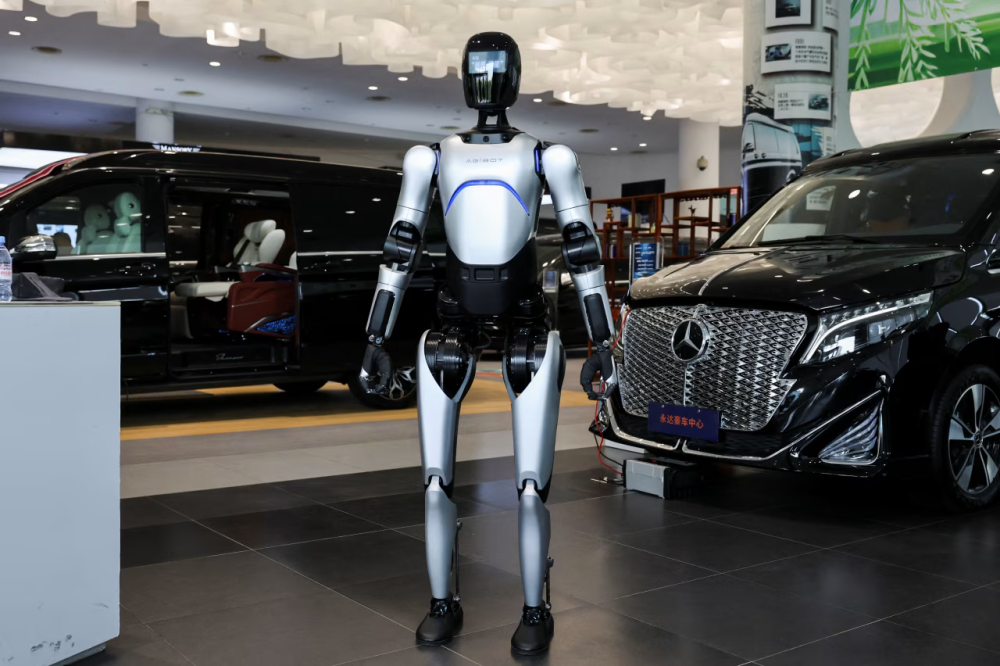
Khi Mỹ theo đuổi trí tuệ nhân tạo siêu việt (AGI), Trung Quốc lại chọn con đường thực dụng hơn:
-
Từ sau khi ChatGPT ra mắt, Mỹ đổ hàng tỷ USD vào mục tiêu xây dựng trí tuệ nhân tạo tổng quát (AGI) – loại AI vượt qua trí tuệ con người, có thể cách mạng hóa khoa học, quân sự và nền kinh tế toàn cầu.
-
Trong khi đó, Trung Quốc, dưới sự lãnh đạo của Tập Cận Bình, không mấy hứng thú với AGI mà tập trung vào AI thực dụng, giá rẻ và hiệu quả, nhằm phục vụ các ứng dụng cụ thể như:
-
Chấm bài thi trung học,
-
Tư vấn nông nghiệp và dự báo thời tiết,
-
Triển khai robot trong nhà máy tự động,
-
Hỗ trợ bác sĩ tại bệnh viện AI,
-
Giám sát an ninh và xử lý khẩn cấp.
-
-
Chính phủ Trung Quốc hậu thuẫn mạnh mẽ với quỹ đầu tư AI trị giá 8,4 tỷ USD, kết hợp chính sách “AI+” khuyến khích ứng dụng công nghệ vào tất cả lĩnh vực từ sản xuất đến nghiên cứu khoa học.
-
Thay vì đốt hàng gigawatt điện để huấn luyện mô hình khổng lồ, Trung Quốc đẩy mạnh AI mã nguồn mở, giúp giảm chi phí, tăng tốc độ triển khai và lan rộng ảnh hưởng ra toàn cầu.
-
Do bị Mỹ hạn chế tiếp cận chip cao cấp, Bắc Kinh không thể cạnh tranh về mô hình “khủng”, nên chọn làm “người theo sau thông minh”, tận dụng công nghệ hiện có để triển khai sớm và hiệu quả.
-
Dù các công ty như Alibaba hay DeepSeek vẫn tuyên bố hướng đến AGI, nhưng nhà nước Trung Quốc thể hiện sự cẩn trọng, tránh rủi ro cho sự ổn định chế độ.
-
Trong khi Mỹ bắt đầu hoài nghi về khả năng thành công của AGI, với các tên tuổi lớn như OpenAI và Meta chững lại, chiến lược thực dụng của Trung Quốc có thể tỏ ra thông minh hơn, nhanh hơn và hiệu quả hơn trong ngắn hạn.
-
Tuy nhiên, Mỹ vẫn có lợi thế về hệ thống giáo dục rộng mở, sáng tạo công nghệ và khả năng thu hút nhân tài, giúp duy trì tiềm năng vượt lên nếu biết tận dụng.
📌Mỹ đổ hàng tỷ USD vào mục tiêu xây dựng trí tuệ nhân tạo tổng quát (AGI), còn Trung Quốc, dưới sự lãnh đạo của Tập Cận Bình, không mấy hứng thú với AGI mà tập trung vào AI thực dụng, giá rẻ và hiệu quả, nhằm phục vụ các ứng dụng cụ thể Đây có thể không phải cuộc đua để mơ, mà là cuộc đua để thắng bằng hành động cụ thể. Chính phủ Trung Quốc hậu thuẫn mạnh mẽ với quỹ đầu tư AI trị giá 8,4 tỷ USD, kết hợp chính sách “AI+” khuyến khích ứng dụng công nghệ vào tất cả lĩnh vực từ sản xuất đến nghiên cứu khoa học.
https://www.wsj.com/tech/ai/china-has-a-different-vision-for-ai-it-might-be-smarter-581f1e44
China Has a Different Vision for AI. It Might Be Smarter.
With growing fears of an AI bubble, Beijing is charting a pragmatic alternative to Silicon Valley’s pursuit of artificial superintelligence
By
Josh Chin
and
Raffaele Huang
Aug. 30, 2025 11:00 pm ET
A robot at a car dealership in Shanghai.
The U.S. is spending billions of dollars and burning gigawatts of energy in a rush to beat China to the next evolutionary leap in artificial intelligence—one so great, some boosters say, that it will rival the atomic bomb in its power to change the global order.
China is running a different race.
Since the release of OpenAI’s ChatGPT nearly three years ago, Silicon Valley has spent mountains of money in pursuit of AI’s holy grail: artificial general intelligence that matches or beats human thinking. Enthusiasts say it will give the U.S. insurmountable military advantages, help cure cancer and solve climate change, and eliminate the need for people to perform routine work such as accounting and customer service.
In China, by contrast, leader Xi Jinping has recently had little to say about AGI. Instead, he is pushing the country’s tech industry to be “strongly oriented toward applications”—building practical, low-cost tools that boost China’s efficiency and can be marketed easily.
The diverging visions represent a head-to-head bet with significant stakes. If China’s gamble turns out to be wrong, it could find itself lagging far behind the U.S. in the most consequential technology of the 21st century.
Chinese leader Xi Jinping is pushing the country’s tech industry to focus on applications for AI.
But if AGI remains a distant dream, as more people in Silicon Valley now believe, China will be in position to steal a march on its global rival in wringing the most out of AI in its current form, and spread its applications worldwide.
Already in China, domestic AI models similar to the one that powers ChatGPT are being used, with state approval, to grade high-school entrance exams, improve weather forecasts, dispatch police and advise farmers on crop rotation, say state media and government reports.
Tsinghua University, China’s equivalent of the Massachusetts Institute of Technology, is rolling out an AI-powered hospital, where human doctors will be assisted by virtual colleagues armed with the latest data on diseases. Intelligent robots are being deployed to run automotive “dark factories” and inspect textiles for flaws while still on the loom.
“They see highly impactful AI applications not as something to theorize about in the future but as something to take advantage of here and now,” said Julian Gewirtz, a former National Security Council official who specialized in tech competition with China during the Biden administration.
U.S. tech companies are developing plenty of practical applications using current AI, of course. Google has wired its latest Pixel smartphones to do real-time translation, while U.S. consulting companies are using AI agents to build PowerPoint decks and sum up interviews for clients. Others are using it to improve drug discovery and food delivery.
But unlike the U.S., which largely leaves the industry to its own devices, Beijing is putting the full muscle of the state behind its vision. In January, the central government unveiled an $8.4 billion AI investment fund focused on supporting startups. Local governments and state banks have since rolled out their own funding programs, while cities have published AI development plans as part of a campaign dubbed “AI+.”
On Tuesday, China’s cabinet spelled out broader ambitions for the campaign, calling for an even stronger push to integrate AI into science and tech research, industrial development and other areas to “comprehensively empower” China’s economic development by 2030.
China is also more actively embracing open-source models that are free for users to download and modify, making it cheaper and easier for Chinese companies to build businesses around the technology. That approach is helping Chinese AI spread globally, a trend that has shaken Silicon Valley into following suit.
AGI dreams
That emphasis is somewhat different from the ambitions of many of the U.S.’s biggest tech players, who believe that machines that can outthink humans will revolutionize science, open up entirely new fields of inquiry and transform the American military.
Some in the tech industry have predicted that artificial superintelligence could arrive as soon as 2027. Companies such as Meta, Google and OpenAI are spending lavishly in a competition to acquire the talent, data centers and energy they need to be first.
A congressional commission focused on competition with China has floated a “Manhattan Project” for AGI to ensure the U.S. wins the race.
But OpenAI’s highly anticipated release in August of GPT-5, a model the company had initially touted as a major steppingstone on the path to AGI, left many users underwhelmed.OpenAI’s Sam Altman acknowledged the bumpy rollout and has since tried to tap the brakes on AGI hype and warned about the possibility of an AI investment bubble.
Other Silicon Valley titans have also started to waver, opening the door to the idea that China’s approach might make more sense.
“It is uncertain how soon artificial general intelligence can be achieved,” former Google Chief Executive Eric Schmidt and technology analyst Selina Xu wrote in a recent opinion column for the New York Times.
“In being solely fixated on this objective, our nation risks falling behind China, which is far less concerned with creating A.I. powerful enough to surpass humans and much more focused on using the technology we have now.”
Pragmatic approach
The Chinese government’s enthusiasm for more-practical uses of AI is visible in Xiong’an, Xi’s built-from-scratch dream city two hours south of Beijing.
In February, the city announced the release of an agricultural AI model, using technology from the Chinese startup DeepSeek, which gives local farmers guidance on crop selection, planting and pest control, according to a local government report. The city’s meteorological service is using DeepSeek to improve the accuracy of weather reports. DeepSeek is also helping local police analyze case reports and decide how to respond to emergencies.
The Chinese government is using several AI applications to help run the city of Xiong’an.
Xiong’an’s branch of 12345, a government question hotline that fields hundreds of thousands of calls a day nationwide, is using DeepSeek to sort and route inquiries.
A major portion of government investment is going to build data centers. But unlike the sprawling facilities being built in the U.S. to train cutting-edge models, the Chinese versions tend to be smaller.
To a large extent, Beijing has no choice but to break a different trail on AI. U.S. trade restrictions, particularly on high-end semiconductors, have made it difficult for Chinese AI companies to compete head to head with American giants in scaling up the training of the most advanced models.
The choice makes even more sense given growing uncertainty about the return on investment of chasing scale, said Jeffrey Ding, a professor at George Washington University and author of ChinAI, a newsletter focused on Chinese AI.
“You let the technology leader, the U.S. in this case, eat the cost of exploration, and then you try to be the fast follower or be the one who optimizes for implementation,” he said.
The Chinese tech company Alibaba has said it would pursue artificial general intelligence.
To be sure, some Chinese companies, including DeepSeek and Alibaba, have said they would pursue AGI. And some analysts have speculated that China could be trying to keep a lid on some of its AGI ambitions.
It is possible, even likely, that Xi will decide at some point to more aggressively pursue AGI, said Kendra Schaefer, head of tech-policy research at Trivium China, a Beijing-based consulting firm. But he will do so cautiously with plenty of safeguards, she said, given the potential risk that thinking machines could pose to Communist Party stability.
“It is one of the most risk-averse governments on the planet,” she said.
As with the internet, which had to weather the dot-com crash and years of development before being able to rewire the global economy, it could take decades to determine winners and losers in AI, according to George Washington University’s Ding.
The U.S. has important advantages over China in harnessing new technologies, he said, including a broad education system beyond elite universities that can spread technical knowledge widely.
If it is careful to maintain that edge, Ding said, the U.S. has a good chance at eventually beating China at its own race.
Thảo luận
Follow Us
Tin phổ biến



